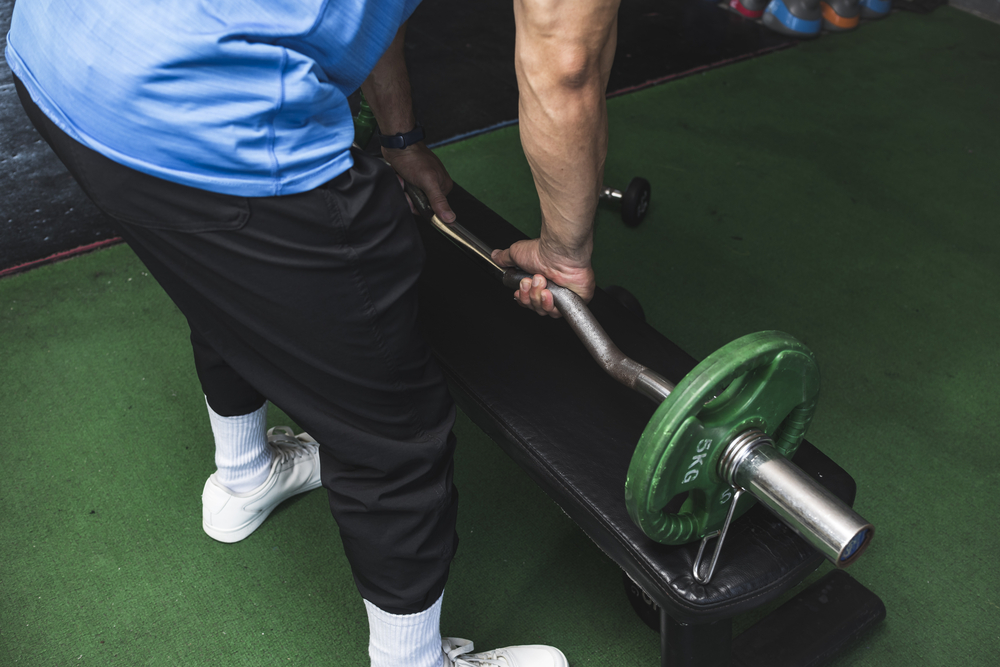Reverse curls are a variation of standard barbell curls.
With the pronated grip (palms-down) being used, it looks a little bit different to barbell curls, although you could be forgiven for thinking it’s an almost identical exercise.
Reverse curls are actually a highly effective exercise in their own right though.
In this article, we take a look at which bicep head reverse curls focus on, as well as looking at the anatomy of your biceps, how to work each head a little bit more, and any other muscles that come into play during reverse curls.

Which Bicep Head Do Reverse Curls Work?
As reverse curls are quite similar (in some ways) to standard barbell curls, they’re quite an adaptable exercise.
This means that they have the capacity to work both the long head and the short head of your biceps.
The bicep head reverse curls actually works depends on your hand position, the equipment being used, and your movement throughout the exercise.
How To Target The Long Head More
Adopting a narrower grip during standard barbell curls puts more focus on the long head of your biceps.
The same is true of reverse curls.
By having your hands closer together on the bar, your long head has more stress placed upon it which can lead to increased growth of your bicep peak.
Although your biceps aren’t the only muscles working during reverse curls, performing them with a close grip can be help them activate more during the exercise with a focus on the long head.
How To Target The Short Head More
As a close grip on the bar during reverse curls brings the long head of your biceps into play more, it makes sense that the opposite (a wide grip) would target the opposing head to a greater extent.
If you want to put more focus on the short head of your biceps during reverse curls, using a wide grip on the bar is a simple way of doing this.
You need to bear in mind that other muscles will be working throughout the movement, so your biceps won’t be working in isolation.
But changing to a wider grip will certainly bring the short head of your biceps into play more than other hand positions.
What Other Muscles Do Reverse Curls Work?
Reverse curls are a great exercise for working a large percentage of your arm muscles rather than just focusing on one specific muscle.
The target muscles of reverse curls are:
- Biceps
- Brachioradialis
- Brachialis
The Brachioradialis is a muscle in your forearm that works as a forearm flexor.
It sits lower down your arm than your bicep, but it can be seen to “prop up” your biceps if it’s developed enough to do so.
This can make your biceps look bigger by pushing it up from beneath.
The Brachialis is a muscle that sits underneath your biceps and helps with flexing the elbow.
This muscle plays its biggest part in any curling exercise as the weight begins to be lifted from the lowest point of the movement.
Reverse curls help build your forearms and your biceps, so they can be a great exercise to use in a general arm-building program.
The Anatomy Of The Biceps
The large muscle at the front of your upper arm is your biceps.
It’s located between your shoulder and your elbow and is the muscle responsible for flexing your elbow and rotating your forearm.
Although it’s commonly known as the biceps, the scientific (Latin) name for it is biceps brachii.
This translates as “two-headed muscle of the upper arm” which is a pretty accurate description of your biceps.
The two heads of your biceps are the short head and the long head.
Both heads have different effects on the way your biceps look.
The short head of your biceps is the head that adds thickness or width to the muscle.
The long head is the one responsible for the highly sought-after biceps peak.
Sources
Reverse Barbell Curls Muscles Worked
I’ve been in the fitness and strength training industry for nearly a decade. In that time, I’ve gained 30 pounds of muscle, written hundreds of articles, and reviewed dozens of fitness supplements. As for my educational background, I’m a currently studying for my Active IQ Level 3 Diploma in Personal Training.

